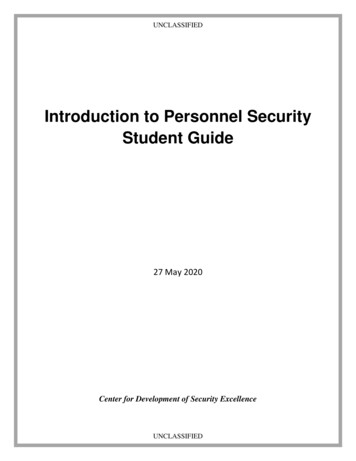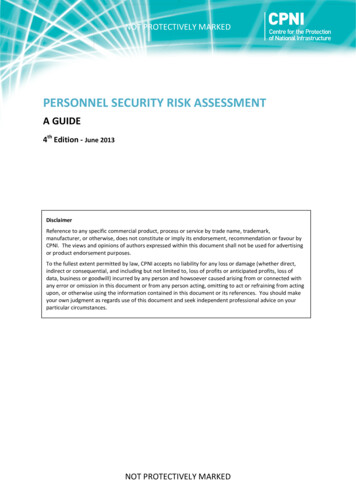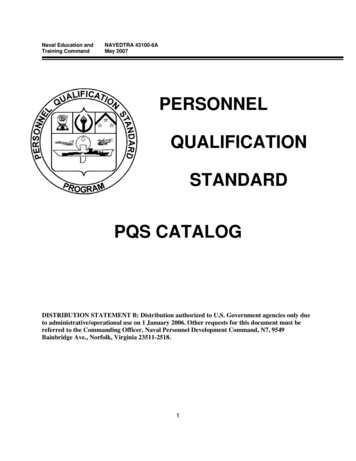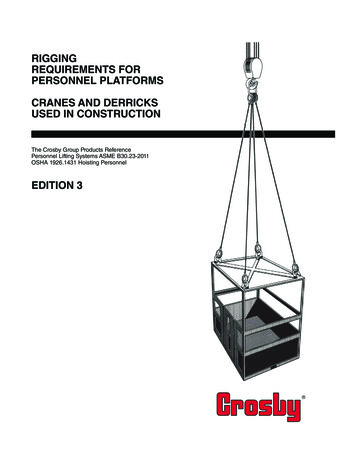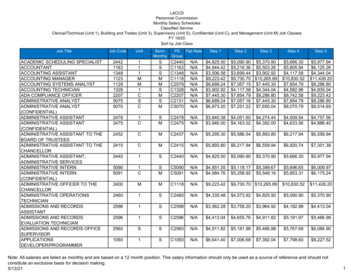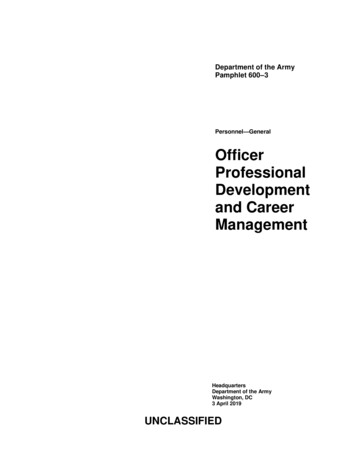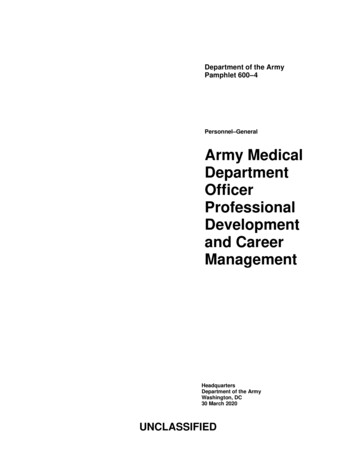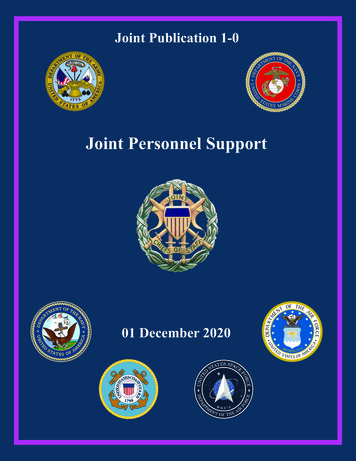
Transcription
ENTTMHIT OF T HS W E' L LDEFEENDARDSTMTEERU NII CA MY DE PARJoint Publication 1-0AT E S O FAJoint Personnel Support01 December 2020
PREFACE1. ScopeThis publication is the keystone document of the personnel series. It providesfundamental principles and guidance to plan, coordinate, provide, and assess manpowerand personnel support to joint operations.2. PurposeThis publication has been prepared under the direction of the Chairman of the JointChiefs of Staff (CJCS). It sets forth joint doctrine to govern the activities and performanceof the Armed Forces of the United States in joint operations, and it provides considerationsfor military interaction with governmental and nongovernmental agencies, multinationalforces, and other interorganizational partners. It provides military guidance for the exerciseof authority by combatant commanders and other joint force commanders (JFCs), andprescribes joint doctrine for operations and training. It provides military guidance for useby the Armed Forces of the United States in preparing and executing their plans and orders.It is not the intent of this publication to restrict the authority of the JFC from organizingthe force and executing the mission in a manner the JFC deems most appropriate to ensureunity of effort in the accomplishment of objectives.3. Applicationa. Joint doctrine established in this publication applies to the Joint Staff, combatantcommands, subordinate unified commands, joint task forces, subordinate components ofthese commands, the Services, the National Guard Bureau, and combat support agencies.b. This doctrine constitutes official advice concerning the enclosed subject matter;however, the judgment of the commander is paramount in all situations.c. If conflicts arise between the contents of this publication and the contents of Servicepublications, this publication will take precedence unless the CJCS, normally in coordinationwith the other members of the Joint Chiefs of Staff, has provided more current and specificguidance. Commanders of forces operating as part of a multinational (alliance or coalition)military command should follow multinational doctrine and procedures ratified by the UnitedStates. For doctrine and procedures not ratified by the United States, commanders shouldevaluate and follow the multinational command’s doctrine and procedures, where applicableand consistent with US law, regulations, and doctrine.For the Chairman of the Joint Chiefs of Staff:STUART B. MUNSCHVice Admiral, United States NavyDirector for Joint Force Developmenti
PrefaceIntentionally BlankiiJP 1-0
SUMMARY OF CHANGESREVISION OF JOINT PUBLICATION 1-0DATED 31 MAY 2016 Added a section pertaining to operation assessments. Annotated United States Space Force/United States Space Command asappropriate with peer Service and combatant commander (CCDR) authorities andresponsibilities throughout the document. Updated geographic combatant commander/functional combatant commander toCCDR, throughout the document. Added language recognizing gender inclusivity and diversification efforts. Clarified language regarding a commander’s role in combatting sexual assault. Removed Annex E from Appendix B, “Sample Format for Annex E (Personnel) toOperation Plans.” Updated language specifying contingency decision timeframes which pertain toreserve component activation and benefit eligibility. Updated language regarding evacuation and repatriation operations. Added language clarifying postal service support requirements and joint forcecommander/Service component responsibilities as they pertain to operation length. Updated references to reflect current title and issuance. Modified, added, and removed terms and definitions from the DOD Dictionary ofMilitary and Associated Terms.iii
Summary of ChangesIntentionally BlankivJP 1-0
TABLE OF CONTENTSEXECUTIVE SUMMARY . viiCHAPTER IPRINCIPLES OF PERSONNEL SUPPORT, ORGANIZATION, AND FUNCTION General . I-1Authorities. I-1Principles of Personnel Support Within a Joint Force Command . I-2Organization of the Joint Force Manpower and Personnel Directorate . I-2Function of the Joint Force Manpower and Personnel Directorate . I-3CHAPTER IIROLES AND RESPONSIBILITIES Responsibilities of Secretary of Defense, Chairman of theJoint Chiefs of Staff, Military Department Secretaries,Service Chiefs, and Department of Defense Agencies .II-1Combatant Command Responsibilities .II-2Joint Force Command Manpower and Personnel Directorate Responsibilities.II-4Service Component Responsibilities .II-9Other Command and Component Responsibilities .II-10Other Operational Considerations.II-14CHAPTER IIIJOINT PERSONNEL PLANNING General . III-1Personnel Estimate . III-1Joint Manning Document Development . III-1Operation Plan Personnel Annex . III-3Flow of Forces Into the Theater . III-3Joint Task Force Headquarters Manning . III-3Organization of a Joint Task Force Manpower and Personnel Directorate . III-5Personnel Visibility . III-5Sexual Assault Prevention and Response Program . III-8Assessment . III-9APPENDIXABCDEFPersonnel Estimate . A-1Sample Format for Annex E (Personnel) to Operation Plans .B-1Joint Force Manpower and Personnel Directorate Checklist .C-1Declaration of Contingency Operations . D-1Natural Disaster and Catastrophic Event Actions . E-1Individual Augmentation Planning and Procedures . F-1v
Table of ContentsGHJKLMNOPQRSJoint Personnel Processing Center and Joint PersonnelTraining and Tracking Activities . G-1Military Pay, Allowances, and Entitlements . H-1Postal Operations. J-1Morale, Welfare, and Recreation . K-1Casualty Operations and Casualty Reporting. L-1Awards and Decorations .M-1Performance Reporting and Tracking . N-1Civilian Personnel Management . O-1Language and Regional Expertise Management . P-1Personnel Support to Multinational Operations . Q-1References .R-1Administrative Instructions . S-1GLOSSARYPart IPart IIAbbreviations, Acronyms, and Initialisms . GL-1Terms and Definitions . GL-6FIGUREI-1II-1III-1H-1L-1viNotional Joint Force Manpower and Personnel DirectorateOrganizational Chart . I-3Morale, Welfare, and Recreation Programs .II-8Joint Personnel Accountability Reconciliation andReporting Data Sources . III-7Joint Operations Entitlement Matrix . H-2Casualty Reporting Flowchart . L-2JP 1-0
EXECUTIVE SUMMARYCOMMANDER’S OVERVIEW Describes the principles of personnel support, organization, and function. Outlines the responsibilities of Secretary of Defense, Chairman of the Joint Chiefsof Staff, Military Department Secretaries, Service chiefs, Department of DefenseAgencies, and combatant commanders in relation to personnel policies. Discusses joint force command manpower and personnel directorate and Servicecomponent responsibilities for manpower management, personnel management,and personnel support. Describes considerations for joint personnel planning and the means by whichthe manpower and personnel directorate of a joint staff envisions the desiredobjective(s) in support of the commander’s mission requirements.Principles of Personnel Support, Organization, and FunctionPersonnel services support is a sustainment functionexecuted at the tactical, operational, and strategic levels bythe Services pursuant to statutory authority. Thoroughplanning and comprehensive personnel managementenables the joint force commander (JFC) to identify andallocate forces to achieve national security objectives.Personnel services support relies on secure and nonsecure,continuous, and survivable communications and digitalinformation systems from the JFC’s headquarters (HQ)and each Service. These systems provide a commonoperational picture, asset visibility, and predictivemodeling to facilitate accurate and timely manningdecisions.AuthoritiesJFCs exercise their authority to implement personnelprograms and coordinate personnel services supportfunctions of their Service components to implementpersonnel programs in support of joint operations pursuantto statutory authority and Department of Defense (DOD)issuances and Chairman of the Joint Chiefs of Staff (CJCS)directives. The manpower and personnel directorate of ajoint staff (J-1) assists the JFC in tailoring personnelprograms when planning for joint operations.vii
Executive SummaryPrinciples of PersonnelSupport Within a JointForce CommandPrinciples of personnel support within a joint forcecommand include: Command emphasis.Synchronization of personnel support.Integration.Flexibility and responsiveness.Organization of the JointForce Manpower andPersonnel DirectorateThe J-1 section of a joint force headquarters (JFHQ) maybe organized with:Function of the JointForce Manpower andPersonnel DirectorateThe J-1: A personnel readiness division which providesplans, policy, and guidance on joint personnel issues. A human capital division which provides policyoversight on joint manpower and management ofjoint forces and US contributions to multinationalmilitary organizations. A personnel services division which administersinternal military and civilian personnel programs ofthe joint force. Plans and assesses force structure, personnelsustainment, and support concepts for each phase ofoperations. Advises staff members on personnel matters that mayimpact ongoing operations and influence future jointplanning. Coordinates with higher, supporting, supported, andsubordinate manpower and personnel directorates, aswell as associate organizations of various UnitedStates Government (USG) departments and agencies,host nations, and multinational forces (MNFs).Roles and ResponsibilitiesResponsibilities ofSecretary of Defense,Chairman of the JointChiefs of Staff, MilitaryDepartment Secretaries,Service Chiefs, andDepartment of DefenseAgenciesviiiSecretary of Defense (SecDef). SecDef establishespolicy, assigns responsibilities, and prescribes proceduresfor personnel readiness issues for the Active Component(AC), Reserve Component (RC), DOD civilians, andcontractors.CJCS. The CJCS, in consultation with the other membersof the Joint Chiefs of Staff, advises SecDef on manpowerand personnel issues impacting the readiness of the ArmedJP 1-0
Executive SummaryForces of the United States and the force structure requiredto support achievement of national security objectives.Secretaries of the Military Departments. Functions ofthe Secretaries of the Military Departments are outlined inthe United States Code. These functions are to recruit,organize, supply, equip, train, service, mobilize,demobilize, administer, and maintain the Services.Services. To perform the joint personnel visibility mission,Services should provide personnel data to the DefenseManpower Data Center (DMDC) daily and have thecapability to accept or receive feedback from the DMDC.DOD Agencies. DOD agencies formulate and publishpolicies and procedures outlining the requirement for theirdeployed, deploying, and redeploying personnel to adhereto combatant commander (CCDR) guidance on entry/exitprocedures.Combatant CommandResponsibilitiesThe CCDR establishes personnel policies to ensure properand uniform standards of military conduct.The CCDR utilizes the manpower, workforce, andindividual augmentation capabilities in the Fourth EstateManpower Tracking System (FMTS) to provide visibilityof personnel assigned. The Joint Staff provides selecteddata elements to the DMDC on an automated, daily basis.Joint Force CommandManpower and PersonnelDirectorateResponsibilitiesManpower and Personnel. The J-1 is the principal staffdirectorate responsible for manpower management,personnel management, and personnel support. Althoughthe Services have the primary responsibility for providingpersonnel services support to their Service members, the J1 will track the efforts of Service components to stay abreastof personnel activities and issues that could impact the jointforce. The J-1 develops joint plans, policy, and guidance onmanpower and personnel issues; coordinates manpower andpersonnel support to facilitate the success of operations; andmaintains a dialogue with other staff directorates, Servicecomponents, and outside military and civilian agencies,while also keeping subordinate commanders informed ofpersonnel actions that affect their command and theirService members.ix
Executive SummaryService ComponentResponsibilitiesService components account for all personnel, includingAC, RC, and DOD civilians, and civilian contractorsunder their control. Accountability begins immediatelyupon establishment of a command relationship for militarypersonnel and upon arrival in the area of responsibility(AOR) for performance by contractor personnel.Other Command andComponentResponsibilitiesThe J-1 provides support and assistance to the office ofprimary responsibility on the following matters:Other OperationalConsiderations RC call-up.Stop-loss authority.Evacuation and repatriation operations.Personnel recovery operations.Detainee operations.Although not applicable in all situations, the followingissues should be considered when planning personnelsupport to joint operations: Single-Service Manager. The commander mayassign responsibility for providing or coordinatingsupport for all Service components in the designatedtheater or operational area to a single component. Women, Peace, and Security. DOD strives toexemplify a diverse organization that allows for women’smeaningful participation across the development,management, and employment of the joint force. Uniform Policies. Policies governing uniform wearfor deployed military and civilian personnel are aService responsibility; however, the CCDR mayestablish basic uniform standards in the AOR, asappropriate. Evaluation Reports. Performance evaluation reportsare a Service responsibility. Each Service has specificpolicies and directives concerning evaluations.During deployments or other situations wheremembers of several Services work together on atemporary basis, the CCDR may wish to set basicguidance concerning performance reports andestablish evaluation periods for deployed personnelthat coincide with Service-specific guidance.xJP 1-0
Executive Summary Personnel Accountability in Conjunction WithNatural or Man-Made Disasters. When anatural/man-made disaster or catastrophic eventoccurs, the CJCS will provide guidance regardingpersonnel accountability. When directed, CCDRs andthe Services will provide operational reports for theCJCS and SecDef to gain and maintain situationalawareness of the operational environment within thedisaster area. Multinational Operations. US-led joint task forces(JTFs) should expect to participate as part of an MNFin most future military endeavors throughout therange of military operations. Such participation withMNFs may be more complex than US unilateralorganization, planning, and operations. Redeployment Operations. As military forcesprepare for redeployment, the focus of personnelsupport by the J-1 includes managing the personnelflow to home station; drawing down, reorganizing,and closing out the personnel services supportstructure in the AOR or joint operations area (JOA);maintaining personnel accountability; and continuingto provide personnel support to those forcesremaining in the AOR or JOA.Joint Personnel PlanningJoint personnel planning is the means by which the J-1envisions the desired objective(s) in support of thecommander’s mission requirements.The combatant command (CCMD) J-1 should be fullyinvolved throughout the joint planning process andcollaborate with other staff directors in the preparation ofthe commander’s estimate, plan development, and forceflow conferencing.Personnel EstimateThe personnel estimate collects and analyzes relevantinformation for developing (within the time limits andavailable information) courses of action and informingdecision making that supports and impacts the planningand execution of the mission.xi
Executive SummaryJoint Manning DocumentDevelopmentEffectively transitioning a single-Service organizationfrom its routine, Service-related missions to that of a JTFHQ requires specific steps.Key to this process is creating a joint manning document(JMD) that will define the JTF HQ’s overall manpowerrequirements needed to complete its mission. The JMDcan be filled through multiple sourcing methods, toinclude units, multinational partners, other USGdepartments and agencies, and contractors.Operation Plan PersonnelAnnexA well-developed personnel annex within the CCDR’soperation plan (OPLAN) is the best method to widelydisseminate theater requirements. When the concept ofoperations has been established, the J-1 provides input tothe OPLAN in annex E (Personnel), which outlines theplan for personnel support.Flow of Forces Into theTheaterThe J-1 planners with time-phased force and deploymentdata (TPFDD) or FMTS experience attend force flowconferences or planning conferences to ensure personnelsupport and services support requirements are properlyreflected in the TPFDD or FMTS database.Joint Task ForceHeadquarters ManningJTFs may take many forms and sizes as they are employe
Manpower Tracking System (FMTS) to provide visibility of personnel assigned. The Joint Staff provides selected data elements to the DMDC on an automated, daily basis. Joint Force Command Manpower and Personnel Directorate Responsibilities Manpower and Personnel. The J-1 is the princip

